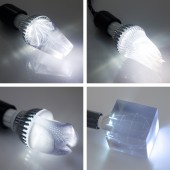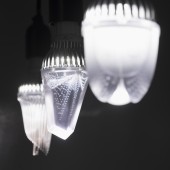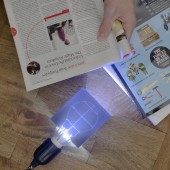Printed Bulbs Light Bulb by Eric Brockmeyer + Karl Willis |
Home > Winners > #27060 |
 |
|
||||
| DESIGN DETAILS | |||||
| DESIGN NAME: Printed Bulbs PRIMARY FUNCTION: Light Bulb INSPIRATION: To rethink the form factor of the conventional ‘Edison bulb’ using new manufacturing technology. UNIQUE PROPERTIES / PROJECT DESCRIPTION: The ‘Printed Bulbs’ series explores new forms for light bulbs using a specialized 3D printing process. Internal bubbles and light pipes are precisely fabricated and embedded inside each bulb to guide and reflect light. The finished bulb is attached to a universally compatible energy-efficient LED light socket. OPERATION / FLOW / INTERACTION: Each light bulb can be attached to any existing lighting fixture, such as a chandelier or desk lamp, or used individually as a pendant lamp or free-standing light. PROJECT DURATION AND LOCATION: The project was developed from 2011-2012 in Pittsburgh, USA. FITS BEST INTO CATEGORY: Lighting Products and Fixtures Design |
PRODUCTION / REALIZATION TECHNOLOGY: Each bulb is fabricated layer by layer from a digital file using a 3D printing process. The liquid resin deposited by the 3D printer is cured with UV light and hardens into a clear polymer. Mounting hardware are embedded during the print process to attach the LED socket. SPECIFICATIONS / TECHNICAL PROPERTIES: Standard Edison screw mount fitting. Bulb base diameter: 60mm. TAGS: Design, light, bulb, bubbles, light pipes, clear, resin, 3D print, additive manufacturing RESEARCH ABSTRACT: The ‘Printed Bulbs’ are created using a specialized 3D printing process developed in-house. Within the clear bulb material internal structures are carefully designed to guide and reflect light. Internal bubbles are precisely created by slowly closing up small self-supporting air gaps. Light from the LED is reflected off the bubbles to create unique illumination patterns. Light pipes are used to guide light from point to point using a second material shaped like a hollow tube. Light enters and continuously reflects through the light pipe and exits at the other end. These techniques can be fabricated entirely in a 3D printer to enable new form-factors for lighting design. CHALLENGE: Optical lighting elements have traditionally been expensive and impractical to produce in small quantities due to the manufacturing precision and finishing required. Internal forms within a lighting element were also very difficult to precisely control using conventional manufacturing. 3D printing with optically clear material enables a wide range of new forms to be created with a greatly simplified fabrication process. ADDED DATE: 2012-11-05 06:17:59 TEAM MEMBERS (2) : Eric Brockmeyer and Karl Willis IMAGE CREDITS: Eric Brockmeyer + Karl Willis, 2012. |
||||
| Visit the following page to learn more: http://www.disneyresearch.com/printedopt |
|||||
| CLIENT/STUDIO/BRAND DETAILS | |
 |
NAME: Disney Research Pittsburgh PROFILE: - |
| AWARD DETAILS | |
 |
Printed Bulbs Light Bulb by Eric Brockmeyer + Karl Willis is Winner in Lighting Products and Fixtures Design Category, 2012 - 2013.· Press Members: Login or Register to request an exclusive interview with Eric Brockmeyer + Karl Willis. · Click here to register inorder to view the profile and other works by Eric Brockmeyer + Karl Willis. |
| SOCIAL |
| + Add to Likes / Favorites | Send to My Email | Comment | Testimonials | View Press-Release | Press Kit |






